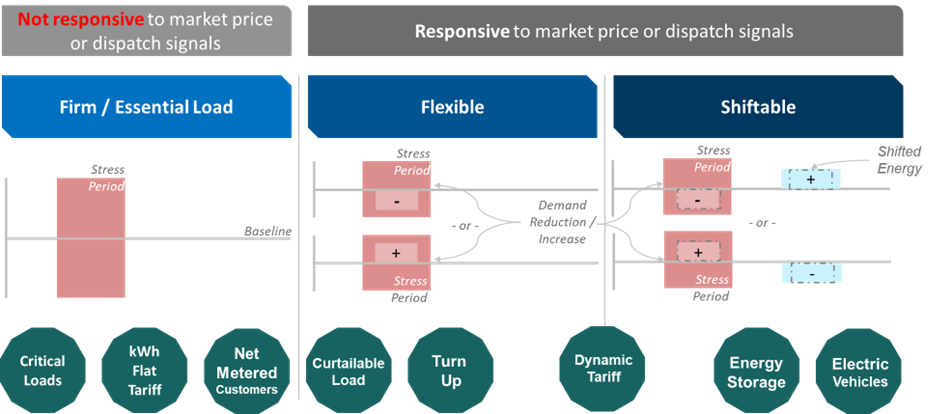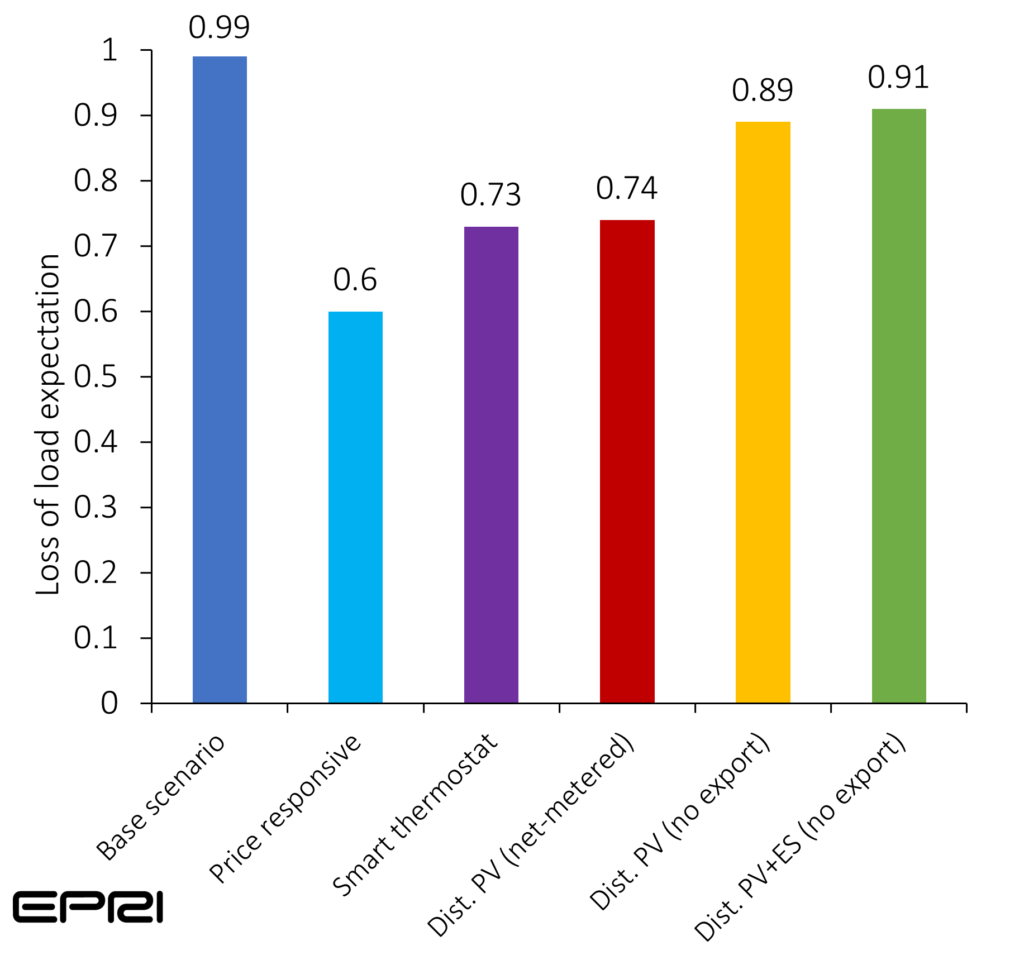The way that demand flexibility and distributed resources are modelled in resource adequacy has a significant impact on resource adequacy. That impact will grow over time as decentralization of the power system continues apace.
Resource Adequacy Is About the Ability to Avoid Load Shedding
Grids have inherited a resource adequacy assessment framework that has been synthesized over time into a requirement for sufficient generating capacity to meet demand with a high level of certainty. But the lines are not quite so clear cut in the emerging power system—demand is a concept of customer utility which can be translated into power and energy, but which is influenced by incentives, tariffs, smart controls, customer-owned PV, storage, and the changing nature of customers’ loads.
In this context, the first point to consider is what a resource adequate system would be. In recent work at the Electric Power Research Institute (EPRI), we presented the concept that the system should have a sufficient set of resources to avoid involuntary load shedding with some level of certainty and acceptable level of impact. To do so, a system would need to have sufficient supply capacity, available energy, flexibility, and frequency control resources. A clear focus on preventing involuntary load shedding should also be established, separating the concept of demand into one part that is flexible and elastic and another that is fixed and inelastic, hence, shed involuntarily.
Demand Flexibility Is Crudely Modelled in Resource Adequacy Assessments
Demand flexibility is sometimes considered in resource adequacy assessments with two common tools. Structural changes, such as improving energy efficiency and adoption of new technologies, alter the reference demand forecast for a given year. On the supply side, adequacy tools implement detailed models for thermal, renewable, and hydro generation and battery storage, whereas demand response is modelled more simply: resources and customer behaviors that materialize in the short term are typically lumped together and modelled as demand response that is dispatched akin to a gas turbine.
Many ways to classify demand and systems’ related programs and tariffs have been proposed. In the context of resource adequacy assessment, we classified demand into three classes in our studies: firm or essential, flexible, and shiftable (Figure 1). Firm demand offers no flexibility. Flexible demand results in lower or higher load during system stress periods, and shiftable demand results in lower load during system stress peak periods at the expense of higher load at another time.
Figure 1. Demand classification for resource adequacy assessment

Source: Electric Power Research Institute.
Demand Flexibility and DER Make a Meaningful Contribution When Measured
Using real world data from a large utility area, we examined the impact of explicit representations of flexible and shiftable demand types upon resource adequacy assessment outcomes. In a case study of the same system, we examined a 1 percent penetration of four different flexible demand and distributed energy resource (DER) types in a time series, including:
-
- Price-responsive load—day ahead (flexible)
- Smart thermostat programs (shiftable)
- Residential demand with behind the meter solar (firm, net metering and no-export tariff)
- Residential demand with behind the meter solar and storage (firm + shiftable, no-export tariff)
In the first case, a portion of load that is assumed to respond to a single kWh tariff is replaced by a fully price-responsive demand responding to day-ahead hourly prices, but maintaining equivalent annual energy usage. In the second case, 1 percent of capacity is replaced with a load profile that includes the ability to shift heating, ventilation, and air conditioning loads within a three-hour period of deferral. In the third case, we model the impact of adding DER to a customer on a fixed tariff, first where there is net metering, and second where there is no export allowed. In the final case, we look at the net profile of customers who have PV and storage but are not allowed to export to the grid. (1)
What we found in our first case study indicates that the way customers’ flexibility (first two cases) and how their DER is operated (last two cases) are modelled makes a meaningful difference to the outcome of resource adequacy assessments. Those outcomes, in turn, inform the need for new supply resources, the design of demand response programs, and the accreditation of resources to provide capacity. In all cases, the loss of load expectation (LOLE) was reduced, but more so for the fully flexible price-responsive and smart thermostat cases that rely more on customer engagement than those cases with customer-owned supply and storage added (see Figure 2). The implication for planners from this single study is that representation of the demand side’s flexibility is at least as important as the attention that is paid to modelling the supply side.
Figure 2. Changes in the Loss of Load Expectation for a test system with 1 percent penetration of distributed flexibility programs and technologies.

Source: Electric Power Research Institute.
What Do These Results Mean for the Future of Resource Adequacy?
Three clear messages emerge for resource adequacy practitioners to be able to better reflect the impact that demand-side flexibility and customer behavior have on resource adequacy:
-
- A conscious effort is needed to rebalance the disparity in detail between supply, storage, and demand representations in resource adequacy assessments in order to better reflect the underlying risk of involuntary load shedding.Demand flexibility does not neatly fit into a model of a conventional generator or battery storage resource dedicated models for major demand classifications are needed in resource adequacy tools and assessments.
- Such analyses need data which is often not collected or available within the same organization. Standard data collection frameworks related to demand flexibility are likely needed to support such additional models.
In addition, there are many caveats to studies such as these. Some notable ones in this context are that:
-
- We have only examined one system, and the effect in other systems is likely to differ substantially. The effect may go both ways—to increase or decrease reliability relative to a business-as-usual baseline.
- Sufficient and comparable customer data sets are scarce and may not be available within the same organization that is responsible for assessing resource adequacy. Baseline data sets are needed to compare customers moving from one type of tariff or incentive program to another, which is often not available. Randomized control group–type experiments are rare and, when they exist, are often dated.
- Forecasting aggregate demand is a challenging task made even more challenging by the need to forecast the adoption of various programs and incentives by customers and their resulting response. Nevertheless, it is reasonable to expect that some portion of customers would enroll in such programs designed to enhance demand flexibility.
- The impact of weather is of great importance both for renewables and for demand. Limited data and experience are available to generate models that replicate customer behaviours in successive resource adequacy events under a range of conditions: controllable demand response, voluntary programs, or even public appeal messages, such as were issued in California this month.
Irene Danti Lopez, Research Engineer, EPRI Europe
Eamonn Lannoye, Managing Director, EPRI Europe
Angela Chuang, Principal Technical Leader, EPRI
(1.) For reference, the effective load-carrying capability (ELCC) for stand-alone solar in the system exceeds 50 percent in the horizon examined.

Leave a Reply